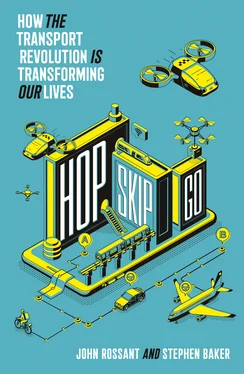In the fight to build the next generation of mobility manufacturing, a host of variables are in flux. The dollar investment in manufacturing is falling, as is the cost of vehicles. Meanwhile, the choice of vehicles is exploding, and each year batteries provide a greater range and lower costs. The challenge, whether the current product is an Arcimoto, a Veemo, a Twizy, or one of the 3-D printed cars coming off a new line in Shanghai, is to build an enduring business plan for times of unrelenting change.
AT THE DAWN of the Internet age, when Kevin Czinger was busy building an online grocery business, the mobility revolution would have been impossible. Yet over the following two decades, crucial technologies advanced dramatically, turning visions like 3-D printed cars from far-fetched fantasies into factory installations.
It’s astounding how many crucial pieces have fallen into place in so little time. Start with data, the feedstock of the information economy. At the turn of the century, the age of data had not yet taken shape. This is because most of us weren’t yet spending our lives interacting with screens and surrounded by sensors, or busily feeding social networks. The networks didn’t learn much about us—our buying habits, our diseases, our networks of friends. Our lives were still largely off-line. Many computers, strange as it sounds today, sat cloistered in “computer rooms.” Laptops had no Wi-Fi. And even if we had uploaded the data on floppy disks to networks, there weren’t yet powerful cloud computers to store and process it, turning our behaviors and movements into insights and fueling crucial advances in artificial intelligence.
In those early Internet years, networked sensors, the eyes and ears of the mobility world, were still in their infancy. By far the most important of these sensors, the smartphones we carry around everywhere, did not yet exist. Without smartphones, an entire wing of the mobility economy, from Uber to dockless bike and scooter companies, would disintegrate. (For those companies, our smartphones are their customers, not us. We’re simply stuff that rides along, the smartphones’ luggage.)
One of the recent breakthroughs in the data economy has been the increased mastery of human language by machines. All our online scribbling and yammering has created massive language sets for computers. In effect, we have taught them language. This enables us to talk to the machines moving us around. Speech is the dominant interface for mobility technology. This wouldn’t have been possible, except in a handful of primitive applications, before about 2015.
By looking back even a decade or two, we can sense the speed of the tech current pushing us forward. It’s fast, and it’s accelerating. The technologies powering the mobility revolution, from AI to manufacturing and network management, are sure to advance just as dramatically over the next decade or two.
The same growth curve is being experienced by 3-D printing. In the first decade of this century, the mere suggestion of harnessing armies of 3-D printers for automobile manufacturing would have sounded outlandish. Such printers in their infancy were mostly for hobbyists. Designers could draw up something on their computers—perhaps a refrigerator handle, or a new stem for a broken pair of sunglasses. But the process was slow. Similar to a child building a sand drip castle at the beach, the printer deposited material layer upon layer, and gradually an object rose into the physical world. It was called “additive” technology. Instead of a child’s stubby fingers dripping sand, a 3-D printer used a precision nozzle that spit out minutely calibrated material, usually plastic. It was miraculous, in its way, but deliberate, built to craft one object at a time. It might have been the next stage of craftsmanship, but it was hardly a rival to mass manufacturing.
Yet the manufacturers of such devices kept shooting ahead. In the last decade, 3-D printers have radically expanded their diet and equipped themselves for more serious work. These digital factories can now consume a variety of metallic powders and a broad array of composites. This increases their range. Their speed, meanwhile, has climbed up the exponential curve familiar to other digital technologies. Traditional carmakers are now using 3-D printers to create certain parts while leaving the rest of their mass-manufacturing process intact.
When it comes to speed, 3-D printing cannot compete with the astounding production of a traditional assembly plant. The question is whether the 3-D printing process will be fast enough for minifactories to make money in niche markets—or if it will be fast enough in three or four years.
DIVERGENT 3D’S FIRST car, which Czinger showcases at mobility conferences, is a sleek, purple sports car called the Blade. It has the curves of a 1950s-era Porsche, yet it weighs only 1,400 pounds. If it had a more modest motor, it could run more than one hundred miles on a gallon of gas. But the show version, built to wow motor-heads and car writers, sacrifices economy for performance. It has the power of 700 horses, and it can accelerate from zero to sixty in a blistering two seconds flat.
The Blade is only a concept car at this point. Divergent’s business, Czinger says, will not be in producing and selling cars, but instead in leasing its manufacturing system—its software—to automakers big and small around the world. Even as 3-D printing grows faster, it will never compete with the productivity of mass manufacturing. But niche markets don’t require such speed or scale. Czinger estimates that simple printed cars with commodity engines will sell for $6,000 or so—not even a third the price of Mark Frohnmayer’s Arcimoto SRK. The plans for the Shanghai factory call for the production of nearly one thousand such cars per month. The number is minuscule by mass-manufacturing standards, but it’s an entirely different business model. If this approach takes off, Divergent 3D could become a global software platform for vehicle manufacturing. That is Kevin Czinger’s goal.
2 2: LA: Crawling to Topanga Canyon 3: 800 Electric Horses 4: Jurassic Detroit 5: Helsinki: Weaving Magic Carpet Apps 6: In the Company of Hawks and Nightcrawlers 7: Dubai: Grasping for the Cutting Edge 8: Idiot Savants at the Wheel 9: Shanghai: Petri Dish on the Huangpu 10: Squadrons of Pack Drones Conclusion: Minutes, Meters, and Moolah Acknowledgments Notes List of Searchable Terms Praise for Hop, Skip, Go About the Authors Also by Stephen Baker About the Publisher
LA: Crawling to Topanga Canyon 2: LA: Crawling to Topanga Canyon 3: 800 Electric Horses 4: Jurassic Detroit 5: Helsinki: Weaving Magic Carpet Apps 6: In the Company of Hawks and Nightcrawlers 7: Dubai: Grasping for the Cutting Edge 8: Idiot Savants at the Wheel 9: Shanghai: Petri Dish on the Huangpu 10: Squadrons of Pack Drones Conclusion: Minutes, Meters, and Moolah Acknowledgments Notes List of Searchable Terms Praise for Hop, Skip, Go About the Authors Also by Stephen Baker About the Publisher
The story of Los Angeles, like that of most cities, is a tale of changing mobility. Until the 1880s, LA was a small river town at the foot of the San Gabriel Mountains, fifteen miles from the Pacific shore. The few thousand European Americans who lived there had either made a harrowing transcontinental journey across mountains and deserts in wagons drawn by animals, or they’d taken extravagant detours in ships, some of them sailing twelve thousand miles around Tierra del Fuego.
When trains from the east finally reached the town, they unleashed a wave of migration. In 1888, as two competing railroads, Union Pacific and Santa Fe, battled for the nascent Southern California market, a price war erupted. A passenger in Kansas City could travel all the way to Los Angeles for as little as twenty dollars, then ten dollars, and during one spectacular promotion, a single dollar. To these first travelers, this rolling conquest of an entire continent must have seemed magical.
Читать дальше












